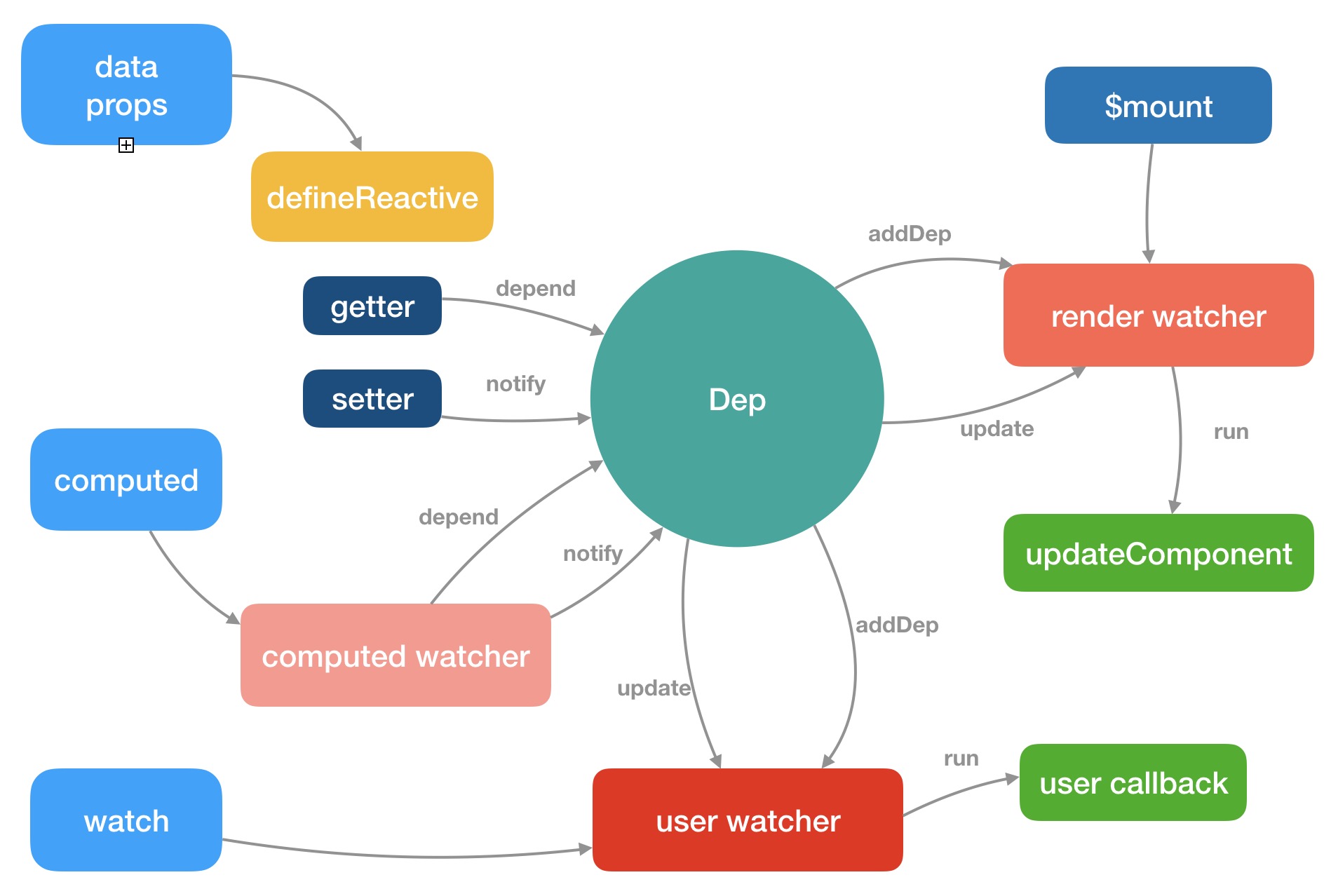# Vue2.x源码分析 - 响应式原理
之前new Vue(options).$mount(el)主要讲述的是,初始化时模板解析并通过虚拟DOM,把数据渲染成真实DOM。但这过程中还做了一部分,就是监听数据变化,DOM数据也更新(一般是用户交互引起数据变化)。以下看看Vue是如何实现数据的变更触发 DOM 的变化。
// src/core/instance/state.js
export function initState (vm: Component) {
vm._watchers = []
const opts = vm.$options
if (opts.props) initProps(vm, opts.props)
if (opts.methods) initMethods(vm, opts.methods) // method代理到vm 实例上
// 注意顺序,data/computed中可以访问props和method
if (opts.data) initData(vm)
if (opts.computed) initComputed(vm, opts.computed)
if (opts.watch && opts.watch !== nativeWatch) {
initWatch(vm, opts.watch)
}
}
# Props
// 响应式props, 并把 props的属性代理到 vm 实例上
// 1. 响应式props数据,会赋值this._props.key
// 2. 代理:使得this.key === this._props.key
// 所以在API层赋值this.key,其实是执行了this._props.key的set方法
function initProps (vm: Component, propsOptions: Object) {
const propsData = vm.$options.propsData || {}
const props = vm._props = {}
for (const key in propsOptions) {
// 核心函数
defineReactive(props, key, value) // 会对vm._props设置响应式key/value
if (!(key in vm)) {
proxy(vm, `_props`, key) // 代理,使得this.key === this._props.key
}
}
}
export function proxy (target: Object, sourceKey: string, key: string) {
sharedPropertyDefinition.get = function proxyGetter () {
return this[sourceKey][key]
}
sharedPropertyDefinition.set = function proxySetter (val) {
this[sourceKey][key] = val
}
Object.defineProperty(target, key, sharedPropertyDefinition) // target.key = {get, set}
}
if (!(key in vm)) {
proxy(vm, `_props`, key) // 使得this.key === this._props.key
}
# data
function initData (vm: Component) {
let data = vm.$options.data
data = vm._data = typeof data === 'function'
? getData(data, vm)
: data || {}
const keys = Object.keys(data)
let i = keys.length
while (i--) {
const key = keys[i]
proxy(vm, `_data`, key) // 使得this.key === this._data.key
}
// 监听整个data
// data数据改动最为频繁,而且data可能会有很深的{}层次
observe(data, true /* asRootData */)
}
export function observe (value: any, asRootData: ?boolean): Observer | void {
if (!isObject(value) || value instanceof VNode) return
let ob: Observer | void = new Observer(value)
return ob
}
export class Observer {
value: any;
dep: Dep;
constructor (value: any) {
this.value = value
this.dep = new Dep() // 收集依赖的容器Dep
if (Array.isArray(value)) {
this.observeArray(value) // 数组,则递归observe,最终会都执行walk函数
} else {
this.walk(value) // 对象,设置响应式(最关键)
}
}
walk (obj: Object) {
const keys = Object.keys(obj)
for (let i = 0; i < keys.length; i++) {
defineReactive(obj, keys[i]) // 核心函数
}
}
observeArray (items: Array<any>) {
for (let i = 0, l = items.length; i < l; i++) {
observe(items[i])
}
}
}
# 依赖收集
典型的订阅者模式,它定义一种一对多的关系,让多个观察者对象同时监听某一个主题对象,这个主题对象的状态发生变化时就会通知所有的观察者对象,使得它们能够自动更新自己。Dep就是主题对象(数组形式),收集并管理着Watcher对象。
每一次defineReactive,即设置key/value时,都会有个Dep收集Watcher。
// defineReactive 的功能就是定义一个响应式对象,给对象动态添加 getter 和 setter,在getter中收集Watcher,在setter执行Watcher逻辑(getter、setter执行时间很巧妙)。
export function defineReactive (
obj: Object,
key: string,
val: any,
customSetter?: ?Function,
shallow?: boolean
) {
// 每一个key/value,都会创建一个Dep用来管理Watch队列
const dep = new Dep()
const property = Object.getOwnPropertyDescriptor(obj, key)
const getter = property && property.get
const setter = property && property.set
if ((!getter || setter) && arguments.length === 2) {
val = obj[key]
}
// 对子对象递归调用 observe 方法。
// 这样就保证了无论 obj 的结构多复杂,它的所有子属性也能变成响应式的对象,这样我们访问或修改 obj 中一个嵌套较深的属性,也能触发 getter 和 setter。
let childOb = !shallow && observe(val) // 如果时复杂数据,递归调用defineReactive
Object.defineProperty(obj, key, {
enumerable: true,
configurable: true,
// get方法调用时间:$mount()执行时,模板编译会访问类似this.xxx,从而触发getter方法
get: function reactiveGetter () {
const value = getter ? getter.call(obj) : val
// 非常巧妙的设计,在此收集Watch依赖(Dep.target = Watcher)
// 在new Watcher()的构造中,会设置Dep.target = this。./watcher.js
if (Dep.target) {
dep.depend() // Watcher收集Dep,同时Dep收集当前Watcher
if (childOb) {
childOb.dep.depend()
if (Array.isArray(value)) {
dependArray(value)
}
}
}
return value
},
set: function reactiveSetter (newVal) {
const value = getter ? getter.call(obj) : val
if (setter) {
setter.call(obj, newVal)
} else {
val = newVal
}
// 对设置的新值,重新监听(设置闭环)
childOb = !shallow && observe(newVal)
dep.notify() // 收集的Watcher开始处理逻辑
}
})
}
export default class Dep {
static target: ?Watcher;
subs: Array<Watcher>;
constructor () {
this.subs = []
}
// Dep收集Watcher
addSub (sub: Watcher) {
this.subs.push(sub)
}
removeSub (sub: Watcher) {
remove(this.subs, sub)
}
depend () {
if (Dep.target) {
Dep.target.addDep(this) // Watcher也收集着Dep
}
}
notify () {
const subs = this.subs.slice() // subs = watchers
for (let i = 0, l = subs.length; i < l; i++) {
subs[i].update()
}
}
}
// Dep.target设置,同一时间(同步代码),Dep.target只有一个
Dep.target = null
const targetStack = []
export function pushTarget (_target: ?Watcher) {
if (Dep.target) targetStack.push(Dep.target)
Dep.target = _target
}
export function popTarget () {
Dep.target = targetStack.pop()
}
export default class Watcher {
constructor (
vm: Component,
expOrFn: string | Function,
cb: Function,
options?: ?Object,
isRenderWatcher?: boolean
) {
vm._watchers.push(this)
if (this.computed) {
this.value = undefined
this.dep = new Dep()
} else {
this.value = this.get() // 等于new Watcher(),会设置Dep.target
}
}
get () {
pushTarget(this) // 设置Dep.target
const vm = this.vm
let value = this.getter.call(vm, vm) // 如:getter等于updateComponent
popTarget()
return value
}
addDep (dep: Dep) {
const id = dep.id
if (!this.newDepIds.has(id)) {
this.newDepIds.add(id)
this.newDeps.push(dep)
if (!this.depIds.has(id)) {
dep.addSub(this) // dep增加Watcher
}
}
}
depend () {
if (this.dep && Dep.target) {
this.dep.depend()
}
}
// 消费Watcher(在 mount 过程中)
updateComponent = () => {
vm._update(vm._render(), hydrating)
}
new Watcher(vm, updateComponent)
# 总结
- 在
new Vue()时,init会数据监听,会把data/props数据递归放在Object.defineProperty中代理,同时依赖收集Watcher,为响应式打基础。 - 在
app.$mount(el)时,会执行new Watcher(),Watcher构造函数中:- 会去执行updateComponent,即先vm_render()拿到VNode,vm._update()虚拟DOM对比,并更新到真实DOM。
vm_render()又会解析模板,模板中又会使用到data/props(this.key会触发data.key的getter函数)。此时会使用到第一步的数据监听部分(终于把两者串联了),因为Object.defineProperty作用就是在拿到data.key的同时,还能做一些额外的逻辑(通过getter/setter)。- getter中做依赖收集。具体是每个data.key都有个Dep对象,在getter函数中,把当前Watcher(Dep.target)增加到Dep对象(谁叫你模板用到了data.key呢)。
会把当前Watcher作为Dep.target。
- 会去执行updateComponent,即先vm_render()拿到VNode,vm._update()虚拟DOM对比,并更新到真实DOM。
- 当
数据变化时,触发data.key的setter方法,收集的Watcher执行回调。watcher队列概念。派发更新的时候,并不会每次数据改变都触发 watcher 的回调,而是在nextTick后执行。watcher队列执行有规则。1. 先把父组件排在子组件前(根据id),因为父组件创建过程要先于子组件。2. 用户自定义watcher优先于渲染watcher。

